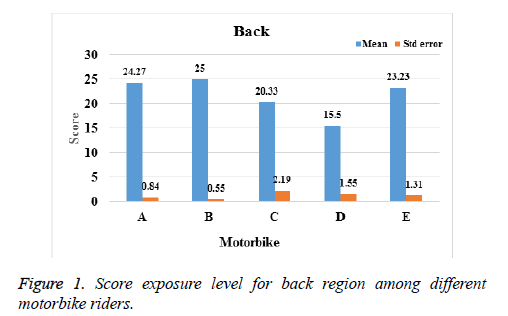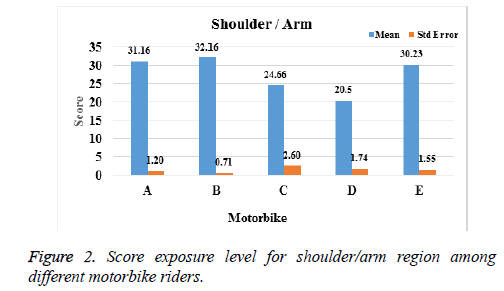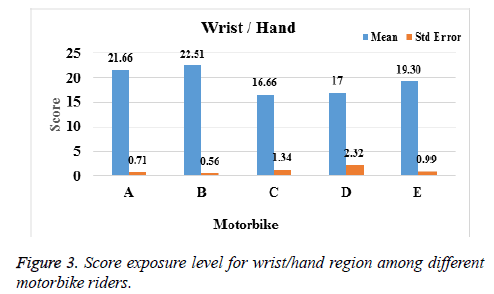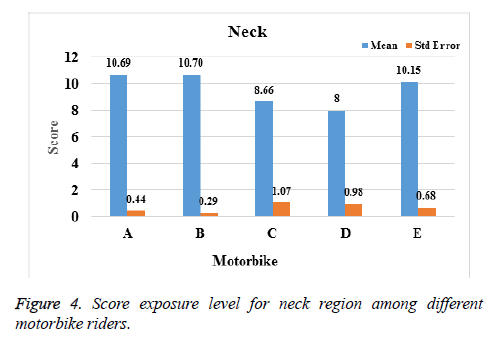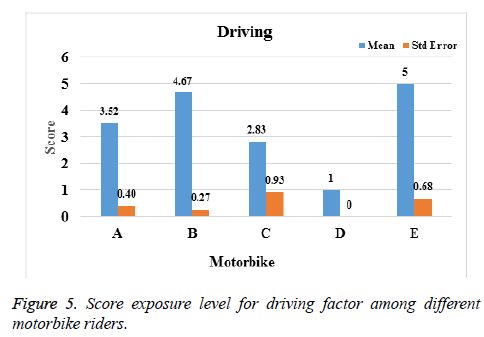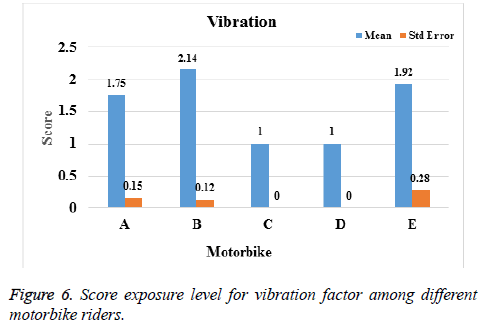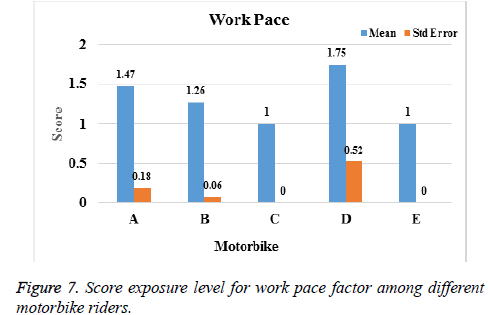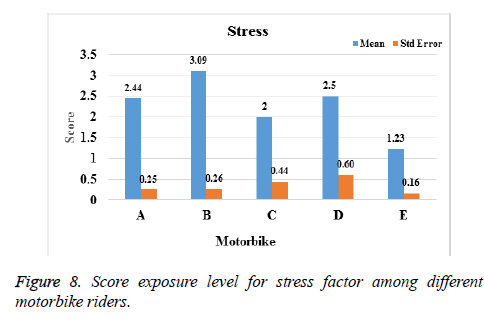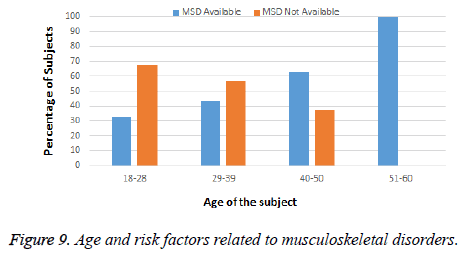ISSN: 0970-938X (Print) | 0976-1683 (Electronic)
Biomedical Research
An International Journal of Medical Sciences
Research Article - Biomedical Research (2017) Volume 28, Issue 5
Evaluation of driving-related musculoskeletal disorders in motorbike riders using Quick Exposure Check (QEC)
1Department of Electronics and Communication Engineering, Manipal Institute of Technology, Manipal University, Manipal, India
2School of Biosciences and Technology, VIT University, Vellore, India
3Department of Electronics and Communication Engineering, PSNA College of Engineering, Dindigul, India
- *Corresponding Author:
- Ramasamy S
Department of Electronics & Communication Engineering
Manipal Institute of Technology Manipal University, India
Accepted on January 17, 2016
Road safety has been a major concern globally with increasing number of vehicles and distance of travel per day. Of the many problems that have been addressed, disorders of the musculoskeletal system among drivers have become a growing public health problem worldwide. QEC is an observational tool developed for Occupational Safety and Health (OSH) practitioners, to evaluate four major areas of the body such as back, shoulder/arm, neck and wrist/hand. The main objective of this study is to investigate the risk factors that are prevalent in the Development of Driving related Musculoskeletal Disorders (DMSD) in 286 Indian motorbike riders using Quick Exposure Check (QEC). The scores obtained using QEC were determined to be high in back and shoulder/arm for motorbike having overall kerb weight between 137 kg to 145 kg and seat height between 785 mm to 790 mm, moderate for bike has weight of 132 kg and seat height of 775 mm and less for motorbike having overall weight of 187 kg and seat height of 800 mm. The scores for wrist/hand were found to be moderate for motorbikes that had less seat height and moderate kerb weight and low for higher seat. The scores computed for neck found to be moderate for all motorbikes. The regions of the body such as back and shoulder/arm had most possible occurrence of driving related musculoskeletal disorders. The study also examines the risk factors for DMSD associated with driving, work pace, vehicle vibration and stress. The results of this study show an exceptionally high occurrence of musculoskeletal disorders among motorbike riders and hence call for a change in the riding posture and modifications in the design of the vehicle.
Keywords
Ergonomics, Driving-related musculoskeletal disorders, Motorbike riders, Quick exposure check.
Introduction
According to the National Crime Records Bureau (NCRB) of India, the road and driving related activities claimed maximum number of lives in the year 2014 which includes a data of 13,787 motor bike riders killed [1] in various accidents. Long term use of motorbikes make the drivers prone to musculoskeletal disorders such as lower back pain, spine injury and disc dislocation. Fatigue and stress has been known to add and contribute largely to the cause of two wheeler accidents in the Indian subcontinent due to various reasons including socioeconomic and work related conditions [2,3]. DMSD mostly occurs as a result of improper driving posture, riding stress and repeated body movements while on move taking into consideration the quality of roads. Of the various known ailments, lower back pain among motorbike riders is a common driving related musculoskeletal disorder [4]. DMSD has a very strong association with vehicle body vibration, lower back pain and spinal injury [5-7]. However, an ergonomic modification of the vehicle seat and hand grip can help to reduce the body vibrations and also alter the driving posture so that it may reduce the DMSD and discomfort among the two wheeler drivers [8].
The Quick Exposure Check (QEC) is one of the observational tools, developed for health practitioners to evaluate an individual’s exposure to DMSD risks. It evaluates four main areas of the body such as back, shoulder/arm, wrist/hand and neck. QEC also computes the score for work pace, driving, vibration and stress [9]. Several studies have earlier reported the occurrence of work-related musculoskeletal disorders among drivers of bus, taxi and truck [5,10-13]. However, in the present study we assess the risk factors that are prevalent in the development of DMSD among motorbike riders using QEC. This study deduces a data that will serve the purpose of modified vehicle designs which in turn will contribute towards reduction of DMSD risk and low physiotherapeutic measure for the afflicted DMSD patients.
Materials and Methods
Subjects
This study was designed for a total of 286 participants who ride Indian made motorbikes in the sub-continent of India’s southern zone where 70% of the total population are two wheeler riders. The confidence level and confidence interval considered were 95% and 6 respectively. Hence the sample size calculated was 286. Southern Zone of India holds 13.2% maximum share in total number of two wheeler accidents occurred in India. The starting age of the riders was considered to be a minimum of 18 years given the legal permission to drive. All the subjects were informed about the purpose of study and all of them were male subject within the age group of 18 to 60 years. Each subject was allowed to decide their participation and for the purpose had to complete a survey. The participated subjects were riding motorbike everyday approximately 1 h per day or more on different quality of Indian roads. Qualitatively Indian roads are a mix of modern highways, narrow and unpaved roads.
Study
Driving related musculoskeletal disorders for Indian motor bike riders were evaluated using Quick Exposure Check. Li and Buckle developed QEC in 1998 and it is modified by David et al. in 2003. QEC, an observational tool [9] to evaluates the risk of exposure to various vehicle impacts on the routine drivers for back, shoulder/arm, wrist/hand and neck. It also evaluates the risk levels for driving, vibration, work pace and stress. The computed score were categorized into low, moderate, high and very high level of musculoskeletal disorder. The range of exposure level for back (static) was 8-15 for low, 16-22 for moderate, 23-29 for high and 29-30 for very high. The range of exposure level for back (moving), shoulder/arm and wrist/hand was 10-20 for low, 21-30 for moderate, 31-40 for high and 41-60 for very high. The range of scores for neck was 4-6 for low, 8-10 for moderate, 12-14 for high and 16-20 for very high. The range of scores for driving, vibration, work pace and stress were defined from 1 to 4, corresponding to low, moderate, high and very high in increasing order of exposure and risks [9].
As understood and well explored technique, QEC is found to be widely accepted by ergonomists and practitioners for determining the risk factors [10]. The arbitrary names assigned to different make of motorbikes was A, B, C, D and E. The motorbikes considered for the study are the mostly used motorcycle around the southern region of India. The motorbikes were selected based on the technical specifications which majorly affects the drive such as gear, suspension, weight of the vehicle, wheel base and seat design.
Depending on the total population and age groups of motorbike riders, the number of subjects pertaining to their age groups was selected.
The technical specifications for the vehicle are given as follows:
| Bike A | 1. Suspension : |
| Front suspension-Telescopic Forks. | |
| Rear suspension- Triple rated Spring. | |
| 2. Height and weight: | |
| Overall weight-144 kg | |
| Overall length-2035mm | |
| Overall width-755mm | |
| Overall height-1060mm | |
| 3. Seat design: | |
| Seat height :785mm | |
| 4. Brake: | |
| Front brake-240mm disc. | |
| Rear brake-130 mm drum. | |
| 5. Wheel design: | |
| Wheel base-320mm | |
| 6. Handle bar grip: | |
| Material type: Aluminium and rubber | |
| Bike B | 1. Suspension: |
| Front suspension-Telescopic hydraulic shock absorbers | |
| Rear suspension- swing Arm (gas reservoir suspension) | |
| 2. Height and weight: | |
| Overall weight-145 kg | |
| Overall length-2080mm | |
| Overall width-765mm | |
| Overall height-1095mm | |
| 3. Seat design: | |
| Seat height :785mm | |
| 4. Brake: | |
| Front brake-240mm disc. | |
| Rear brake-220 mm drum. | |
| 5. Wheel design: | |
| Wheel base-1230mm | |
| 6. Handle bar grip: | |
| Material type: Aluminium and rubber | |
| Bike C | 1. Suspension: |
| Front suspension-Telescopic forks | |
| Rear suspension- Mono suspension | |
| 2. Height and weight: | |
| Overall weight-132 kg | |
| Overall length-1990mm | |
| Overall width-770mm | |
| Overall height-1050mm | |
| 3. Seat design: | |
| Seat height:775mm | |
| 4. Brake: | |
| Front brake-267 mm disc | |
| Rear brake-30 mm drum | |
| 5. Wheel design: | |
| Wheel base-1330mm | |
| 6. Handle bar grip: | |
| Material type: | |
| Aluminium and rubber | |
| Bike D | 1. Suspension: |
| Front suspension-Telescopic forks. | |
| Rear suspension-Twin gas charged shock absorber | |
| 2. Height and weight: | |
| Overall weight-187 kg | |
| Overall length-2180mm; Overall width-790mm | |
| Overall height-1080mm | |
| 3. Seat design: | |
| Seat height :800mm | |
| 4. Brake: | |
| Front brake-280 mm disc | |
| Rear brake-153 mm drum | |
| 5. Wheel design: | |
| Wheel base-1370mm | |
| 6. Handle bar grip: | |
| Material type: Aluminium and rubber | |
| Bike E | 1. Suspension: |
| Front suspension-Telescopic forks. | |
| Rear suspension-Mono tube inverted gas charged shock absorber | |
| 2. Height and weight: | |
| Overall weight-137 kg | |
| Overall length-2085mm | |
| Overall width-730mm | |
| Overall height-1105mm | |
| 3. Seat design: | |
| Seat height:790mm | |
| 4. Brake: | |
| Front Brake-270 mm disc | |
| Rear brake-130 mm drum | |
| 5. Wheel design: | |
| Wheel base-1300mm | |
| 6. Handle bar grip: | |
| Material type: Aluminium and rubber |
The technical specifications that were particular considered for this study were front and back suspension and the material used for handle bar grip. The dimensions such as height, weight, seat height, brake and wheel dimensions were scrutinized for the present study.
Statistical analysis
The Indian motor bike riders were approached and informed about the study. The group of subjects majorly belonged to the Southern part of Indian subcontinent. The subjects participated in the study voluntary after being briefed about the objective of the study. The data was collected and subjected to statistical analysis of Non-parametric ANOVA test. The parameters were defined for different regions of the body to determine the risk factors for different motorbike riders. P values found to be less than 0.05 were considered as statistically significant.
Results and Discussion
A total of 286 Indian Motorbike riders participated in the study. The number of subjects and their age groups are tabulated in Table 1. The standard score level for four main areas of the body such as back (static), back (moving), shoulder/arm, wrist/hand and neck are summarized in Table 2 [9].
| Age (in years) | Number of subjects(N) | Percentage of total subjects |
|---|---|---|
| 18-28 | 136 | 47.55 |
| 29-39 | 128 | 44.75 |
| 40-50 | 16 | 5.59 |
| 51-60 | 6 | 2.09 |
| Total | 286 | 100 |
Table 1. Subjects characteristics.
| Areas of the body | Low | Moderate | High | Very high |
|---|---|---|---|---|
| Back(static) | 8-15 | 16-22 | 23-29 | 30-40 |
| Back(moving) | 10-20 | 21-30 | 31-40 | 41-50 |
| Shoulder/arm | 10-20 | 21-30 | 31-40 | 41-50 |
| Wrist/hand | 10-20 | 21-30 | 31-40 | 41-50 |
| Neck | 4-6 | 8-11 | 12-14 | 16-18 |
Table 2. Standard score level [9].
The QEC scores for different regions of the body such as back, shoulder/arm, wrist/hand and neck for different motorbikes is shown in Figures 1-4 respectively. The QEC scores for back is found to be high for motorbike A, B and E which has a kerb weight between 137 kg to 145 kg, moderate for C has a kerb weight of 132 kg and low for motorbike D, even though the weight of motorbike D is 187 kg.
The scores for shoulder/arm are found to be high for motorbike A and B, moderate for C and E and low for D. The seat height plays a role in risk assessment in back and shoulder/arm. The seat height for motorbike D is 800 mm which is higher compared to the other four vehicles considered under this study. The evaluation reports that the higher seat gives better comfort for the riders. Hence motorbike D results minimum exposure of driving related musculoskeletal disorders. The reasons might also be due to the use of twin gas charged shock absorber rear suspension in motorbike D. Also the dimensions of wheel base, brake, length and width are slightly higher for motorbike D compared to the other four vehicles considered under this study.
The scores for wrist/hand were found to be moderate for motorbikes A and B and low for motorbikes C, D and E. The range of scores obtained for neck region was found to be moderate for all motorbikes considered for the study.
The standard score level for other factors such as driving, vibration, work pace and stress were tabulated in Table 3.
| Other factors | Low | Moderate | High | Very high |
|---|---|---|---|---|
| Driving | 1 | 4 | 9 | -- |
| Vibration | 1 | 4 | 9 | -- |
| Work pace | 1 | 4 | 9 | -- |
| Stress | 1 | 4 | 9 | 16 |
Table 3. Standard score level for other factors.
The scores for other factors such as driving shown in Figure 5 were determined to be medium for B and E and low for rest three vehicles. The vibration, work pace and stress were found to be low for all vehicles shown in Figures 6-8. The usage of proper front suspension and the wheel dimensions of all the vehicles make the vibration exposure to be low. The exposure analysis for other factors is show in Table 4. The overall scores for driving found to be high in 33.80% and low in 44.36% of motorbike riders. In 32.04% and 67.60% of motorbike riders, vibration scores were evaluated as moderate and low respectively. The scores for work pace were moderate and low in 7.74% and 91.54% respectively. The stress scores were evaluated for motorbike riders as very high in 0.70%, high in 11.26% and low in 63.38% (Table 4). The regions of the body such as back and shoulder/arm has most possible occurrence of driving related musculoskeletal disorders. The relationship between risk factors related to motor bike riding related musculoskeletal disorders and age was evaluated (Table 5) using non-parametric ANNOVA test found to be the p value less than 0.05 and it is significant statistically. The degree of freedom was found to be 3 and p<0.05.
| Score | Driving | Vibration | Work pace | Stress | ||||
|---|---|---|---|---|---|---|---|---|
| N | % | N | % | N | % | N | % | |
| 1 | 128 | 44.75 | 194 | 67.83 | 262 | 91.60 | 182 | 63.63 |
| 4 | 62 | 21.67 | 91 | 31.81 | 22 | 7.69 | 70 | 24.47 |
| 9 | 96 | 33.56 | 1 | 0.3494 | 2 | 0.6993 | 32 | 11.11 |
| 16 | --- | --- | --- | --- | --- | --- | 2 | 0.6993 |
| Total | 286 | 286 | 286 | 286 | ||||
Table 4. Exposure level analysis for other factors.
| Age | N | MSD Available | MSD Not available | ||
|---|---|---|---|---|---|
| N | % | N | % | ||
| 18-28 | 136 | 45 | 33.08 | 91 | 66.91 |
| 29-39 | 128 | 56 | 43.75 | 72 | 56.25 |
| 40-50 | 16 | 10 | 62.5 | 6 | 37.5 |
| 51-60 | 6 | 6 | 100 | --- | --- |
Table 5. Age and risk factors related to musculoskeletal disordersstatistical analysis.
The age of the subject is an important factor for DMSD. The age group between 51-60 are more exposed to musculoskeletal disorders than the lower age groups. The subjects between the ages of 40-50, 29-39 and 18-28 have 62.5%, 43.75% and 32.83% of occurrence of DMSD respectively. The analysis results shown in Figure 9 shows that the increase in age results very high possibility of musculoskeletal disorders for motorbike riders.
QEC study was conducted to evaluate driving related musculoskeletal disorders in Indian motorbike riders. Motorbike riding requires more attention, understanding the traffic conditions and physical strength. QEC helps to evaluate the risks related to work related musculoskeletal disorders. QEC is a self-assessment technique but it lacks in evaluating factors such as individual’s habits such as smoking, alcohol consumption [10-13].
The purpose of motorbike suspension is to smoothen the vehicle handling and braking system. It provides safety to the riders from vibrations and bumps in road. Motorbikes considered for the study were using telescopic fork for front suspension. It ensures safety of the vehicle while the front wheels faces the bumps or some imperfections in the road.
Prolonged motorbike riders are closely associated to low back pain [7]. Handle bar grip has a significant association with neck and shoulder related musculoskeletal disorders [14]. Bike riders are exposed to musculoskeletal disorders due to continuous static seating posture [15]. Abnormal driving body postures over a continuous period of time affects muscles, joints and ligaments [10,16]. The evaluation of neck and shoulder musculoskeletal disorders in school bus drivers was found to be higher [17,18]. The study was conducted among professional urban bus drivers The results showed that the exposure levels are very high for shoulder/arm, wrist/hand and neck [7,19]. In our study, the scores obtained using QEC for motorbike riders were determined to be high in back and shoulder/arm due to improper riding posture and more kerb weight, moderate in neck and wrist/hand due to handle bar grip and seat position.
Stress during driving is one of the major factors for musculoskeletal disorders among Hong Kong bus drivers [7,14]. The whole body vibration is also one of the important factors for DMSD among drivers [20]. In our study, the exposure analysis for factors such as driving, vibration, work pace and stress were found to be mostly low for all motorbikes. The age of the driver is closely related to the existence of musculoskeletal disorder [21,22]. Our results show that the increase in the age of motorbike riders is very much exposed to DMSD. There were only 2% of motorcycle users population were under 51-60 age group. Hence the subjects considered for the study of age groups between 50-60 were 6 subjects. It is due to elderly people are experiencing fears of motorbike riding. Light weight, easy to handle motorbike will minimize the DMSD. Based on our analysis, there are significant correlation for risk factors related to musculoskeletal disorders between motorbike riders, taxi and bus drivers. Ergonomic engineering modification in the motorbike handle and seat will reduce the DMSD risks and increases the performance of the riders.
Conclusion
This work is to evaluate driving related musculoskeletal disorders in motorbike riders using QEC. The results signify that the risks related to DMSD are high or moderate in motorbike riders. Risks related to DMSD are due to restricted seating and driving posture, vehicle vibration and stress while driving. The essential ergonomic modification requires in the handle bar grip, vehicle seat design and also there is a need to train the motorbike riders about the seating posture and recommend relieving them from stress will reduce the DMSD rapidly.
Acknowledgement
The authors are thankful to RM Subramanian and the participants of the study for their support and to voluntarily participate to complete the survey.
References
- NCRB. Accidental deaths and suicides in India 2014, 2015.
- Kar S, Bhagat M, Routray A. EEG signal analysis for the assessment and quantification of driver’s fatigue. Transport Res TrafPsycholBehav 2010; 13: 297-306.
- Velagapudi SP, Balasubramanian V, Babu R, Mangaraju V, Madras I, Vellore V. Muscle fatigue due to motorcycle riding. SAE International Small Engine Technology Conference 2010.
- Tushar JP, Arijit KD, Venus KP. A comparative study between core stabilization and superficial strengthening’s exercises for the treatment of low back pain in two wheeler riders. Int J Pharm Bio Sci 2015; 6: 168-176.
- Thamsuwan O, Blood RP, Ching RP, Boyle L, Johnson PW. Whole body vibration exposures in bus drivers: A comparison between a high-floor coach and a low-floor city bus. Int J IndustrErgonom 2013; 43: 9-17.
- Okunribido OO, Shimbles SJ, Magnusson M, Pope M. City bus driving and low back pain: a study of the exposures to posture demands, manual materials handling and whole-body vibration. ApplErgon 2007; 38: 29-38.
- Alperovitch-Najenson D, Katz-Leurer M, Santo Y, Golman D, Kalichman L. Upper body quadrant pain in bus drivers. Arch Environ Occup Health 2010; 65: 218-223.
- Boocock MG, McNair PJ, Larmer PJ, Armstrong B, Collier J, Simmonds M. Interventions for the prevention and management of neck/upper extremity musculoskeletal conditions: a systematic review. Occup Environ Med 2007; 64: 291-303.
- David G, Woods V, Li G, Buckle P. The development of the Quick Exposure Check (QEC) for assessing exposure to risk factors for work-related musculoskeletal disorders. ApplErgonom 2008; 39: 57-69.
- Bulduk EO, Bulduk S, Suren T, Ovali F. Assessing exposure to risk factors for work-related musculoskeletal disorders using Quick Exposure Check (QEC) in taxi drivers. Int J IndustrErgonom 2014; 44: 817-820.
- Raanaas RK, Anderson D. A questionnaire survey of Norwegian taxi drivers musculoskeletal health, and work-related risk factors. Int J IndustrErgonom 2008; 38: 280-290.
- Leinonen V, Kankaanpaa M, Vanharanta H, Airaksinen O, Hanninen O. Back and neck extensor loading and back pain provocation in urban bus drivers with and without low back pain. Pathophysiology 2005; 12: 249-255.
- Finneran A, OSullivan L. Effects of grip type and wrist posture on forearm EMG activity, endurance time and movement accuracy. Int J IndustrErgonom 2013; 43: 91-99.
- Szeto GP, Lam P. Work-related musculoskeletal disorders in urban bus drivers of Hong Kong. J OccupRehabil 2007; 17: 181-198.
- Dutta K, Basu B, Sen D. Identification and quantification of stressors affecting motorized two wheeler riders: an ergonomic attempt. Int J Res 2014; 2: 13-25.
- Kee D, Karwowski W. A comparison of three observational techniques for assessing postural loads in industry. Int J OccupSafErgon 2007; 13: 3-14.
- Gourdeau P. Study of the prevalence of neck and shoulder musculoskeletal disorders in schoolbus drivers. Can J Public Health 1997; 88: 271-274.
- Lewis RJ, Krawiec M, Confer E, Agopsowicz D, Crandall E. Musculoskeletal disorder worker compensation costs and injuries before and after an office ergonomics program. Int J IndustrErgonom 2002; 29: 95-99.
- Yasobant S, Chandran M, Reddy EM. Are bus drivers at an increased risk for developing musculoskeletal disorders? An ergonomic risk assessment study. J Ergonom 2015; 2015.
- Blood RP, Ploger JD, Yost MG, Ching RP, Johnson PW. Whole body vibration exposures in metropolitan bus drivers: A comparison of three seats. J Sound Vibr 2010; 329: 109-120.
- Massaccesi M, Pagnotta A, Soccetti A, Masali M, Masiero C, Greco F. Investigation of work-related disorders in truck drivers using RULA method. ApplErgon 2003; 34: 303-307.
- Hulshof CT, Verbeek JH, Braam IT, Bovenzi M, van Dijk FJ. Evaluation of an occupational health intervention programme on whole-body vibration in forklift truck drivers: a controlled trial. Occup Environ Med 2006; 63: 461-468.
